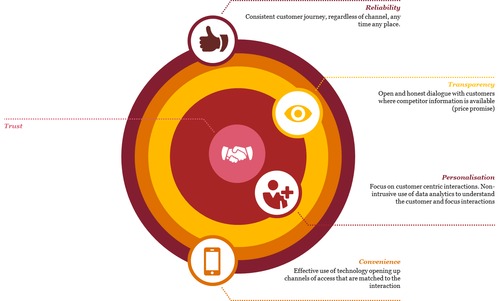
Eoin Daly
The first layer is reliability.
Banks must provide a solid, dependable payments infrastructure. Customers will only tolerate non-functioning ATMs, delayed wage payments or other IT faults for a very short time. In addition, mobile and internet channels have created an “always on” service expectation.
Insurers need to ensure proper use of technology in processing claims. For instance, insurers who utilise in-vehicle telematics can quickly and efficiently assess the variables associated to a claim. This supports a more rapid claims process and allows insurers to quickly respond to their customers when they most need their support.
Cybercrime remains a key operational risk for banks and insurers. Boards of banks and insurers must be educated to effectively manage the threat to people, process, systems and most importantly reputation.
The second layer for banks and insurers to address is convenience.
Banks need to walk in their customers’ shoes and redesign core processes from a customer point of view. Existing technology service providers are already expanding the payment services they offer, arousing interest among the “digital natives”. Witness “Google Wallet” or “Apple Pay” as examples. To counter these threats, banks must ensure that they are the easiest way for all customers to purchase goods and services and transfer funds while providing a 24/7 support service.
For insurers, emerging digital channels in the social and mobile space need to be seamlessly integrated with existing face-to-face, online and phone based channels. Increasingly, customers want to move between these channels during any single transaction. Furthermore, customers increasingly identify and associate an experience with a brand. As such, insurers need to provide a consistent customer centric experience through all channels including the broker channel.
Once reliability and convenience are addressed, the focus should move to transparency.
Price comparison sites that aggregate deals from multiple providers have changed customer expectations for transparent pricing.
Banks should share information on competitor mortgage and deposit rates and explain credit terms in a way that customers can easily understand. Recent mis-selling scandals have left deep wounds in the banking world.
With an increased regulatory spot-light on how banks conduct business, banks need to be more transparent than ever before.
Insurance, healthcare and pension product providers need to establish routes to allow for rapid digestion and comparison of product features by consumers.
Finally, customer centricity requires personalisation.
Banks need to use data analytics to better understand customer behaviours. They must manage every customer relationship to help customers reach their goals. In the past this kind of service was the preserve of the Private Banking or Wealth customers. By 2020, we expect that wealth management will move alongside deposit-taking as a baseline service for retail banking.
PwC’s 2014 research into the future of wearable technology, such as fitness bands, sensor enabled smartphones and smart watches, found that 70% of consumers said they would wear employer-provided wearables streaming anonymous data to a pool in exchange for a break on their insurance premiums. Insurance companies who embrace this and tap into the increasing types of wearable technology can make significant inroads into strengthening customer relationships by specifically tailoring products to match the lifestyles of customers.
To effectively build trust, we must recognise, not only the importance of each layer, but also the interdependencies across the layers. For instance, transparency on product offerings will not be experienced if a customer journey is so inconvenient that the customer exits an engagement. Also, increased capture of behavioral customer data further emphasises the need for reliable protection, and responsible use, of personal data. Remember that trust can take years to earn and build and only seconds to break. Banks and insurers must invest their time wisely.

